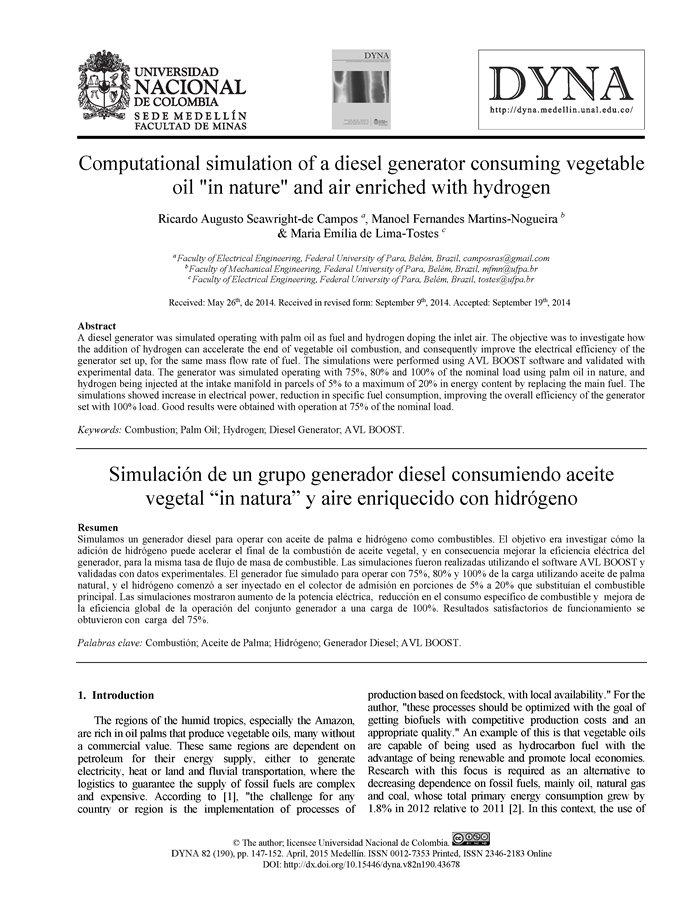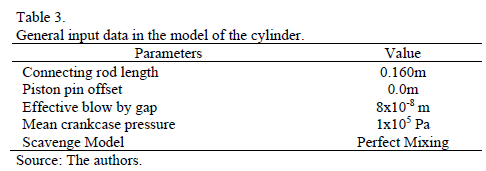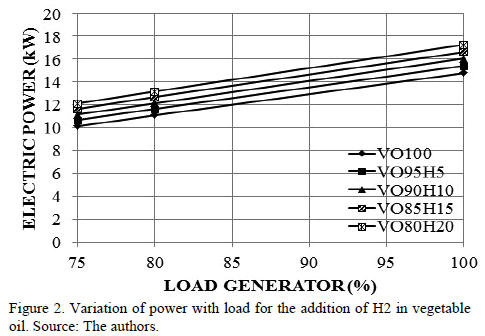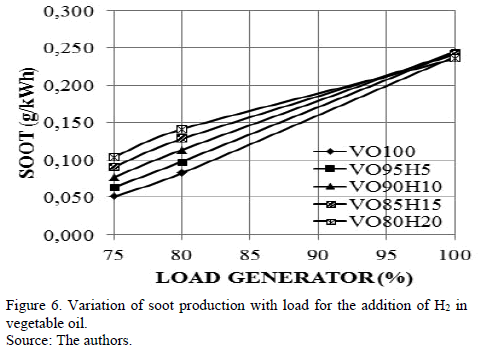
Publicado
Computational simulation of a diesel generator consuming vegetable oil "in nature" and air enriched with hydrogen
DOI:
https://doi.org/10.15446/dyna.v82n190.43678Palabras clave:
Combustion, Palm Oil, Hydrogen, Diesel Generator, AVL BOOST (es)Descargas
DOI: https://doi.org/10.15446/dyna.v82n190.43678
Computational simulation of a diesel generator consuming vegetable oil "in nature" and air enriched with hydrogen
Simulación de un grupo generador diesel consumiendo aceite vegetal "in natura" y aire enriquecido con hidrógeno
Ricardo Augusto Seawright-de Campos a, Manoel Fernandes Martins-Nogueira b & Maria Emília de Lima-Tostes c
a Faculty of Electrical Engineering, Federal
University of Para, Belém, Brazil, camposras@gmail.com
b Faculty of Mechanical Engineering, Federal
University of Para, Belém, Brazil, mfmn@ufpa.br
c Faculty of Electrical Engineering, Federal
University of Para, Belém, Brazil, tostes@ufpa.br
Received: May 26th, de 2014. Received in revised form: September 9th, 2014. Accepted: September 19th, 2014
This work is licensed under a Creative Commons Attribution-NonCommercial-NoDerivatives 4.0 International License.
Abstract
A diesel generator was simulated operating with palm oil
as fuel and hydrogen doping the inlet air. The objective was to investigate how
the addition of hydrogen can accelerate the end of vegetable oil combustion,
and consequently improve the electrical efficiency of the generator set up, for
the same mass flow rate of fuel. The simulations were performed using AVL BOOST
software and validated with experimental data. The generator was simulated
operating with 75%, 80% and 100% of the nominal load using palm oil in nature,
and hydrogen being injected at the intake manifold in parcels of 5% to a
maximum of 20% in energy content by replacing the main fuel. The simulations
showed increase in electrical power, reduction in specific fuel consumption,
improving the overall efficiency of the generator set with 100% load. Good
results were obtained with operation at 75% of the nominal load.
Keywords: Combustion; Palm Oil; Hydrogen; Diesel Generator; AVL BOOST.
Resumen
Simulamos un
generador diesel para operar con aceite de palma e hidrógeno como combustibles.
El objetivo era investigar cómo la adición de hidrógeno puede acelerar el final
de la combustión de aceite vegetal, y en consecuencia mejorar la eficiencia
eléctrica del generador, para la misma tasa de flujo de masa de combustible.
Las simulaciones fueron realizadas utilizando el software AVL BOOST y validadas
con datos experimentales. El generador fue simulado para operar con 75%, 80% y
100% de la carga utilizando aceite de palma natural, y el hidrógeno comenzó a ser inyectado en el colector de
admisión en porciones de 5% a 20% que substituían el combustible principal. Las
simulaciones mostraron aumento de la potencia eléctrica, reducción en el consumo específico de
combustible y mejora de la eficiencia
global de la operación del conjunto generador a una carga de 100%. Resultados
satisfactorios de funcionamiento se obtuvieron con carga del 75%.
Palabras clave: Combustión; Aceite de Palma; Hidrógeno; Generador Diesel; AVL BOOST.
1. Introduction
The regions of the humid tropics, especially the Amazon, are rich in oil palms that produce vegetable oils, many without a commercial value. These same regions are dependent on petroleum for their energy supply, either to generate electricity, heat or land and fluvial transportation, where the logistics to guarantee the supply of fossil fuels are complex and expensive. According to [1], "the challenge for any country or region is the implementation of processes of production based on feedstock, with local availability." For the author, "these processes should be optimized with the goal of getting biofuels with competitive production costs and an appropriate quality." An example of this is that vegetable oils are capable of being used as hydrocarbon fuel with the advantage of being renewable and promote local economies. Research with this focus is required as an alternative to decreasing dependence on fossil fuels, mainly oil, natural gas and coal, whose total primary energy consumption grew by 1.8% in 2012 relative to 2011 [2]. In this context, the use of vegetable oil in natura (VO), that is filtered and degummed only, in internal combustion engines (ICE) as a viable alternative in complete or partial replacement to fossil fuels has been investigated. However, the use of VO in unmodified diesel engines leads to a reduction of thermal efficiency and increased levels of soot [3]. As a proposal to make the use of VO feasible, researchers are introducing other types of fuels as an additive to vegetable oil. [3] carried out performance experiments in a compression ignition engine using vegetable oil from Jatropha plus small quantities of hydrogen (H2) as the main fuel, which led to an improvement in the performance of this engine. One of the major advantages to using H2 as fuel is the absence of carbon in its chemical composition, which means that it has a very high burning rate and, thus, combustion is very fast and its wide range of flammable limits allows use equivalence ratio in the range of 0.1 to 7.1 [4]. The wide flammability of H2 allows the engines that use it as a fuel to operate with very lean mixtures resulting in greater fuel savings and more complete combustion [5]. Variations in both the injected amount of H2 as the types of vegetable oil used has been studied. [6] investigated the use of rubber seed oil, methyl-ester rubber seed oil and diesel as main fuels, and H2 as an inductor, and concluded that there was a decrease in peak pressure in the cylinder with the addition of H2, in addition to an increase in the rate of combustion due to an improvement in the rate of heat release. Following this line of research, this study aimed to simulate the operation of a diesel generator, which occurred without changes in the ICE geometry, and only varying their operational parameters, using palm oil in natura as the main fuel and the addition of small amounts H2 by the intake manifold. The commercial software used was the AVL BOOST, employed by several authors such as [7], [8], [9] and [10], which confers reliability and speed and guarantees that results are achieved.
2. Numerical Methodology
The software adopted for the simulation was the AVL BOOST version 2011.2, which provides a graphical user interface (GUI) composed of icons that represent components of ICE. Once selected and interconnected, the icons allow to open windows through which the geometrical and operational data of the engine, as well as the mathematical models that make up the simulation are inserted [11]. The numerical model created to represent the ICE is shown in Fig. 1.
Table 1 shows the nomenclature of the majors elements used in the computational model and identified in Fig. 1.
Geometric and operational parameters used to create the computational model were obtained from a Hyundai, Model D4BB-G1 generator, with maximum power of 20kVA, consisting of a diesel internal combustion engine, naturally aspirated, four-cylinder and indirect injection. The main characteristics of the engine and generator are shown in Table 2.
2.1. Combustion Model
The combustion model considered was Vibe 2 Zone, which specifies the rate of heat release, considering the burned and unburned mass fractions. Thus, the calculation of the thermodynamic state of the cylinder is based on the 1st Law of Thermodynamics, as shown below:

and the term  covers the enthalpy flow from the unburned to
the burned zone due to the conversion of a fresh charge to combustion products
[12].
covers the enthalpy flow from the unburned to
the burned zone due to the conversion of a fresh charge to combustion products
[12].
2.2. Scavenging Model
The scavenging model considers the scavenging efficiency which is defined as the volume of fresh air in the cylinder related to the total cylinder volume, and the delivery ratio which is defined as the total volume of air which entered the cylinder related to the total cylinder volume. In choosing this model, data were entered as shown in Table 3.
For the scavenging model the standard adopted by AVL BOOST for four-stroke engines was maintained, which is Perfect Mixing model, which considers that the gas entering into a cylinder is immediately mixed with the contents of the cylinder, and the gas leaving a cylinder has the same composition as the mixture of the cylinder [11].
2.3. Heat Transfer Model
The model chosen for heat transfer from the cylinder to walls of the combustion chamber was Woschni (1978), represented by the following equation [12]:

2.4. Pollutants Models
For the calculation of NOx, CO and soot formation standard models were used implemented in AVL BOOST [12]. The NOx formation model is based on Pattas and Häfner model and takes into account 6 elementary reactions based on the Zeldovich mechanism, utilizing 8 species. The CO formation model is based on the Onorati et al. model and takes into account 2 elementary reactions, utilizing 6 species. The soot formation model is based on the Schubiger et al. model and taken into account 2 elementary reactions: one of formation and another of oxidation.
2.5. Validation and Simulation Methodology
After creating the model in AVL BOOST, it was validated with the experimental work [13], with some validation data presented in Table 4.
Table 4 shows that in the validation between simulation and experimental works [13], no significant differences were obtained for Electric Power, Electric Performance and mass flow. Thus, loads were adopted in a generator similar to those used by [13]; that is, 75%, 80% and 100% of full load capacity of the generator. As the combustion in diesel engines occurs by diffuse flame, the combustion occurs at stoichiometric condition. The values adopted for the fuel Lower Heating Value were 38,085 kJ/kg for the VO and 120,043 kJ/kg for the H2. At first, the simulation occurred only with vegetable oil in natura (VO100) as fuel being kept constant its inlet mass flow rate at 1.558 g/s that means genset operating at its full load. After that, the addition of H2 at the entrance of the intake manifold through an injector was simulated.
Similar to [14], this simulation varied the H2 concentration from zero to 20% with steps of 5%. This implies VO reduction of the same amount (in energy basis). As a Lower Heating Value of H2 is greater than the one for VO, the amount of VO energy replaced for H2 was the same, but the amount of mass of H2 that replaced the mass of VO was obviously smaller for each of the simulated cases, as shown in Table 5. The notation adopted for each amount of H2 injected replacing VO were VO95H5 (5% H2), VO90H10 (10% H2), VO85H15 (15% H2) and VO80H20 (20% H2).
3. results and Discussion
Fig. 2 shows variations of the genset output electric power varying the generator load and H2/VO ratio. The simulation showed that there was a linear increase in electrical power provided by the generator, when the H2 content was increased. The output increased 16% at 75% of the nominal load and 14% at full load.
Fig. 3 shows the variation of brake specific fuel consumption (BSFC) with the generator load and H2 concentration. Increasing H2 content, BSFC decreased by 14.2% for operation for full load and decreased by 16.1% with the genset operating with 75% of the generator nominal load. The simulation suggested that the lowest value for the BSFC occurs when the genset run with 20% of H2 and full load. In this case, the specific consumption is 309.13 g/kWh.
Fig. 4 shows NOx concentration in the eluded gases changing the generator load for a different H2/VO ratio. As expected, there was a significant increase in NOx concentration with increasing H2/VO ratio. At full load and 20% H2, the NOx concentration increased 58%. Running under full load and 20% of H2, genset electric power increased from 14.8kW to 17.2kW. This is a consequence of replacing the vegetable oil-air mixture causing a reduction in the amount of air and, therefore, on the amount of N2 raising the mixture's adiabatic flame temperature. As the Zeldovich mechanism is very sensitive to the reactant temperature, the rate of NOx production increases exponentially with gas elevation. As the combustion chamber has excess oxygen and plenty of nitrogen, it results in a greater concentration of NOx on the exhaustion gases in the case of H2 doping.
Fig. 5 shows the variation of CO concentration varying the generator load and H2/VO ratio.
Increasing H2 content raised the CO concentration in exhaust gas by 28.3% when operating at 75% of the nominal load. However, if the H2 content is 20%, the CO concentration stays almost constant independently of the generator load. This fact is very positive, mainly for genset operating in off-grid conditions and required to follow the load. In this case, doping the inlet air with 20% of H2 will cause the CO concentration in the exhaustion gases to be kept constant and independent of the fuel flow rate.
Fig. 6 shows how soot formation varies with the generator load and H2/VO ratio. Raising the load increases soot concentration. At 75% of the nominal load, the amount of soot doubles if the H2 varies from 0 to 20%. On the other hand, at full load the amount of soot produced was almost constant and nearby 0.24 g/kWh. The minimum amounts of soot obtained was for VO100 and reached 0.051 g/kWh. Hydrogen competes for oxygen with carbon. At high load, much more carbon is injected for the same available amount of oxygen, therefore more soot is formed. At 75% load, the competition between carbon and hydrogen is more visible. Once more hydrogen is added, there is an oxygen shortage that promotes soot formation. Fig. 7 shows the volumetric efficiency versus load and H2/VO ratio.
Increasing the generator load and H2 content, the simulation showed a decrease in engine volumetric efficiency of 1.4% at generator load of 75% of the nominal load, and 1.7% when operating at full load. The simulation showed that for full load and 20% in H2 content, volumetric efficiency can fall to 82.6%. This can happen because larger loads will require higher power (Fig. 2), which will increase the average temperature in the combustion chamber and increase the engine wall temperature. Then, engine walls will transfer heat to air in the intake system, reducing the air density, thereby reducing volumetric efficiency.
Fig. 8 shows the genset electrical performance versus load and H2/VO ratio.
At the lowest load, there was a gain of nearly 5% in performance, and a 2.5% gain operating at full load. The simulation showed that the generator can reach values above 25.5% in performance with 20% H2 in vegetable oil.
4. conclusions
The results showed significant improvements in the genset electric power and a decrease in brake specific fuel consumption with increasing hydrogen doping. The overall genset electrical efficiency improved as the hydrogen concentration was raised. The CO production remained constant with the maximum amount of simulated hydrogen for demanded medium and high loads on equipment. The values of NOx and volumetric efficiency show the best levels with the use of vegetable oil in nature than with the introduction of hydrogen, while soot formation was increased but remained at a level close to 0.24 g/kWh, for any amount of tested hydrogen concentration when the genset operates at 100% load. The simulation showed that with the generator operating at medium load (75%), good results were achieved for the brake specific fuel consumption, which remained close to 329 g/kWh. The electrical efficiency of the genset at 75% load was 24%, close to the operation at full load, which was 25.5%. The general conclusion obtained from this simulation is that using hydrogen doping promotes a faster combustion of palm oil, improving its performance and CO emissions remain constant. These findings deserve to be investigated experimentally in gensets operating at medium loads or high loads, especially in regions with complex and expensive logistics, from the point of view of petroleum based fuels supply, such as the Amazon region.
Acknowledgements
To AVL-AST License Extension University Partnership Program - Federal University of Para and grant of use of AVL BOOST software.
References
[1] Benavides, A., Benjumea, P. y Pashova, V., El biodiesel de aceite de higuerilla como combustible alternativo para motores diesel. DYNA, 74 (153), pp. 141-150, 2007.
[2] BP Statistical Review of World Energy. [on line] June 2013. [Consulted April 7th of 2014]. Available at: http://www.bp.com
[3] Kumar, M.S., Ramesh, A. and Nagalingam, B., Use of hydrogen to enhance the performance of a vegetable oil fuelled compression ignition engine. International Journal of Hydrogen Energy, 28 (10), pp. 1143-1154, 2003. DOI: 10.1016/S0360-3199(02)00234-3
[4] Yilmar, A.C., Uludamar, E. and Aydin, K., Effect of hydroxy (HHO) gas addition on performance and exhaust emissions in compression ignition engines. International Journal of Hydrogen Energy, 35 (20), pp. 11366-11372, 2010. https://doi.org/10.1016/j.ijhydene.2010.07.040
[5] Zhou, J.H., Cheung, C.S. and Leung, C.W., Combustion, performance and emissions of ULSD, PME and B50 fueled multi-cylinder diesel engine with naturally aspirated hydrogen. International Journal of Hydrogen Energy, 38 (34), pp. 14837-14848, 2013. https://doi.org/10.1016/j.ijhydene.2013.08.128
[6] Edwin-Geo, V., Nagarajan, B. and Nagalingam, B., Studies on dual fuel operation of rubber seed oil and its bio-diesel with hydrogen as the inducted fuel. International Journal of Hydrogen Energy, 33 (21), pp. 6357-6367, 2008. https://doi.org/10.1016/j.ijhydene.2008.06.021
[7] Carvalho, L.O., Cruz, M.E. C. and Leiroz, A.J.K., Integração de simuladores de processos e de motores para a análise exergética de plantas de potência, VI National Congress of Mechanical Engineering (CONEM), pp. 1-10, 2010.
[8] Almeida, V.T.P., Simulação computacional de emissões e desempenho de um motor diesel operando com óleo diesel e hidrogênio, MSc. Thesis, Pontifícia Universidade Católica de Minas Gerais, Minas Gerais, Brazil, 2012.
[9] Melo, T.C., Análise experimental e simulação computacional de um motor flex operando com diferentes misturas de etanol hidratado na gasolina, Thesis, Universidade Federal do Rio de Janeiro, Rio de Janeiro, Brazil, 2012.
[10] Ferreira, I.A., Sodré, J.R. and Linke, P., Numerical study on injection timing for reduced emissions from an engine operating with diesel oil and hydrogen, 22nd International Congress of Mechanical Engineering (COBEM), pp. 540-546, 2013.
[11] AVL. AVL BOOST Version 2011.2 Users Guide. Austria: 2011.
[12] AVL. AVL BOOST Version 2011.2 Theory Guide. Austria: 2011.
[13] Pereira, R.S., Nogueira, M.F.M. and Tostes, M.E.L., Evaluating indirect injection diesel engine performance fueled with palm oil, 14th Brazilian Congress of Thermal Sciences and Engineering (ENCIT), 143, 2012.
[14] Morais, A.M., Justino, M.A.M., Valente, O.S., Hanriot, S.M. and Sodré, J.R., Hydrogen impacts on performance and CO2 emissions from a diesel power generator. International Journal of Hydrogen Energy, 38 (16), pp. 6857-6864, 2013. https://doi.org/10.1016/j.ijhydene.2013.03.119
R.A. Seawright-de Campos, graduated in Mechanical Engineering in 1987, from the Federal University of Pará - UFPA - Brazil and obtained a MSc in Mechanical Engineering in 2004, from the Federal University of Pará - UFPA - Brazil. Currently, he is currently working on his PhD. in Electrical Engineering at UFPA. He is a professor at the Federal Institute of Education, Science and Technology of Pará - IFPA - Brazil and his area of interest includes modeling and simulation of thermal systems and energy efficiency.
M.F. Martins-Nogueira, graduated in Mechanical Engineering in 1980, from the Federal University of Pará, Brazil, has a MSc in Mechanical Engineering in 1984, from the Federal University of Itajubá, Brazil, and a PhD in 2001, in Combustion from Cornell University, USA. He is an expert on studies, design and construction of SHP from Unifei/Eletrobras. He was Coordinator of Technology at the Ministry of Mines and Energy of Brazil. He is currently an associate professor at the Federal University of Pará and consultant to the IDB and Thermoelectric as well as Hydro Power Plants. He has experience in power generation, with emphasis on water resources, combustion and gasification, acting on the following topics: turbo machinery, study, design, construction and commissioning of hydroelectric and thermoelectric plants, cyclonic combustor, biomass combustion, biomass gasification and use of biofuels in internal combustion engines.
M.E. de Lima-Tostes, graduated in Electrical Engineering from the Federal University of Pará (UFPA), Brazil. Obtained MSc and PhD in Electrical Power Systems all of them from the Federal University of Pará, Brazil. She is a professor at the Federal University of Pará and her main research interests are: power quality issues and energy efficiency.
Cómo citar
IEEE
ACM
ACS
APA
ABNT
Chicago
Harvard
MLA
Turabian
Vancouver
Descargar cita
CrossRef Cited-by
1. Bruno Eustáquio Pires Ferreira, Alex de Oliveira, Vinícius Guerra Moreira, Sérgio de Morais Hanriot. (2023). The effects of biodiesel on the spatial distribution of soot during combustion in a diesel engine-generator group. SAE Technical Paper Series. SAE Technical Paper Series. 1 https://doi.org/10.4271/2022-36-0001.
2. Tan Nguyen Tien, Quang Khong Vu, Nguyen Nhu Thanh, Vinh Nguyen Duy, Vu Minh Dien. (2026). Advances in Engineering Research and Application. Lecture Notes in Networks and Systems. 1610, p.51. https://doi.org/10.1007/978-3-032-03856-2_7.
3. Bruno Eustáquio Pires Ferreira, Vinícius Guerra Moreira, Tales Gonçalves Nazareno, Sérgio de Morais Hanriot. (2021). The effects of injection pressure and energizing time on the combustion of an engine fueled with diesel oil and ethanol blend. SAE Technical Paper Series. SAE Technical Paper Series. 1 https://doi.org/10.4271/2020-36-0255.
Dimensions
PlumX
Visitas a la página del resumen del artículo
Descargas
Licencia
Derechos de autor 2015 DYNA

Esta obra está bajo una licencia internacional Creative Commons Atribución-NoComercial-SinDerivadas 4.0.
El autor o autores de un artículo aceptado para publicación en cualquiera de las revistas editadas por la facultad de Minas cederán la totalidad de los derechos patrimoniales a la Universidad Nacional de Colombia de manera gratuita, dentro de los cuáles se incluyen: el derecho a editar, publicar, reproducir y distribuir tanto en medios impresos como digitales, además de incluir en artículo en índices internacionales y/o bases de datos, de igual manera, se faculta a la editorial para utilizar las imágenes, tablas y/o cualquier material gráfico presentado en el artículo para el diseño de carátulas o posters de la misma revista.




























